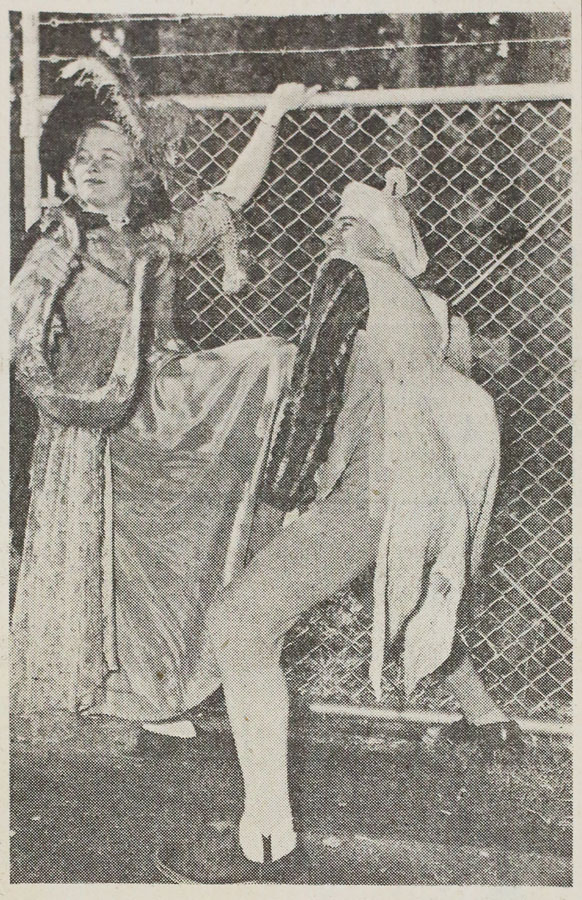
IRIS login | Reed College home Volume 95, No. 4: December 2016
Apocrypha: Traditions, Myths, & Legends
Digging the Dust of Shakespeare’s Bones in Crystal Springs
By Brandon Marrow ’18

“Reed Students Cry Out Against Shakespeare Isle ‘Desecration.’” Photo from the Oregon Journal, Sept. 28, 1950.
In September, 1950, a roving band of Reed students outfitted with lutes and the drama department’s best shot at Elizabethan attire descended on Crystal Springs Island to jump a cyclone fence that had been recently erected by the Rhododendron Society. With a great vertical leap, these students protested the desecration of their beloved “Shakespeare Island” by knavish and unworthy barricades.
Nowadays the bones of this controversy lie deep under the soil, goose-crap, and rhododendron roots of Crystal Springs. Today students know the island (really more like a peninsula) as the section of the Rhodie Garden that sits across a scenic wooden bridge where “fair is ‘fowl’ and ‘fowl’ is fair.”
The Shakespearean roots of the island were sown in 1930, when the LaBarre Shakespeare Club established a Shakespearean garden on the premises. Reed president Dr. Norman F. Coleman was present at the opening ceremony and helped plant the island’s first Shakespearean sapling—an English oak in honor of that oak whose antique root peeped out along a brawling brook in As You Like It. The garden truly flourished when Prof. Barry Cerf [English 1921–48] rallied student support for the project in 1932.
Students in the ’30s considered the island an unofficial part of campus, where they sought reverie and communion with nature. Shakespeare Island appeared in the 1933 student publication “Campus Views,” which included a photo of a student perched in a willow tree by the lake. A 1950 Quest article dubbed the land mass a “Walden” for Reed students and a holy site for the deliberate “religious practice” of the “Reed College Thoreau.” (We aren’t sure exactly what this means, but we get the drift.)
During the tempestuous times brought on by the Depression and World War II, Shakespeare Island grew wild. Reed students doubled their toil and trouble, and journeyed there seeking communion of a different kind. The overgrown isle became known as a nocturnal haven for campfire songs fueled by kegs of Blitz-Weinhard and as a “couples’ retreat” for fulsome frolicking in the ferns.
Eastmoreland residents quickly became acquainted with the rites of the Reed student on the island and, when asked about its purpose, mused that it was where students retired “for intellectual conversation and whatever other activities occur to a Reed College student when the moonlight is too weak to read Shelley in.” These residents were thus delighted when, in June, 1950, Portland City Commissioner Ormond Bean judged Reed students’ endeavors on the island a case of “Love’s Labour’s Lost” and wrote a municipal ordinance handing it over to the Rhododendron Society, which promptly fenced it off.
The barricades provoked outrage from students, who proceeded to stage one of the more unusual protests in Reed’s history. Having scaled the fence, breeches intact, students chanted “For Jesus’ sake forbear—Keep Shakespeare out of Shakespeare Island? Never!” Reporters from the Oregonian and the Oregon Daily Journal rushed to the scene, nine-ironed golfers swore to have seen “pixies” across the lake, and long-suffering Eastmoreland neighbors dismissed the spectacle as much ado about nothing.
Writing in the Quest, students argued that the Rhododendron Society would not promote the ecological health of the island or the Portland public. In a column titled A Serpent’s Tooth, Bill Dickey ’51 declared the rhododendron an invasive species comparable to the Japanese beetle and accused Commissioner Bean of attempting to woo the public with azaleas. Local papers such as the Oregonian responded with scathing remarks about the Reed College “cut-ups.”
In the end, however, the protests availed naught. Shakespeare Island went from on-campus, to off-campus, to off-limits for Reed students. It was thus fitting that students chanted the verses from the Bard’s own epitaph:
Good frend for Jesus sake forbeare, To digg the dust encloased heare; Bleste be the man that spares thes stones, And curst be he that moves my bones.

LATEST COMMENTS
steve-jobs-1976 I knew Steve Jobs when he was on the second floor of Quincy. (Fall...
Utnapishtim - 2 weeks ago
Prof. Mason Drukman [political science 1964–70] This is gold, pure gold. God bless, Prof. Drukman.
puredog - 1 month ago
virginia-davis-1965 Such a good friend & compatriot in the day of Satyricon...
czarchasm - 4 months ago
John Peara Baba 1990 John died of a broken heart from losing his mom and then his...
kodachrome - 7 months ago
Carol Sawyer 1962 Who wrote this obit? I'm writing something about Carol Sawyer...
MsLaurie Pepper - 8 months ago
William W. Wissman MAT 1969 ...and THREE sisters. Sabra, the oldest, Mary, the middle, and...
riclf - 10 months ago